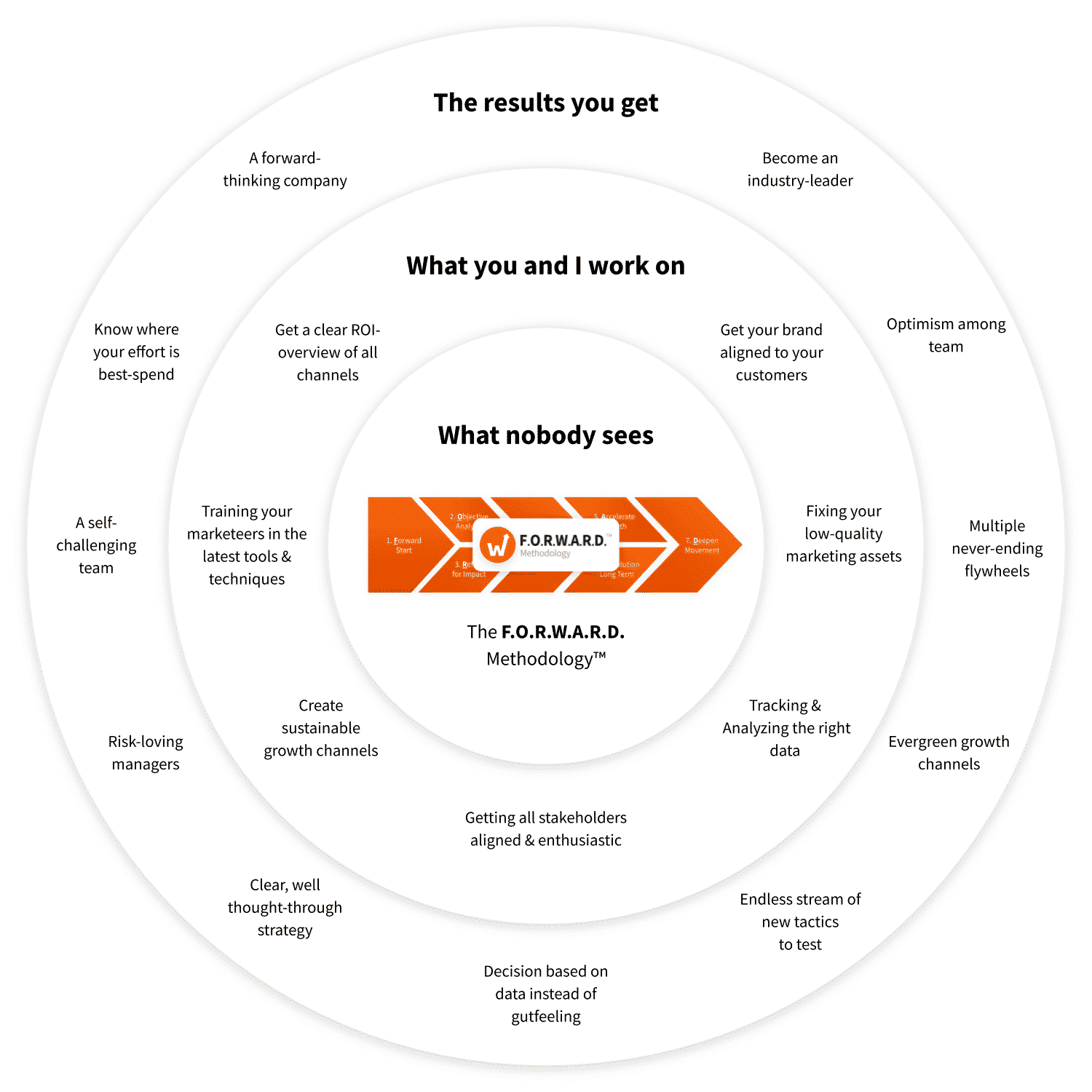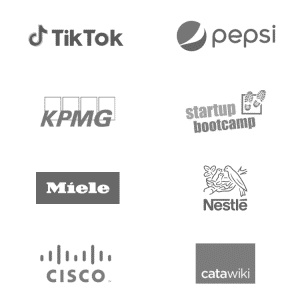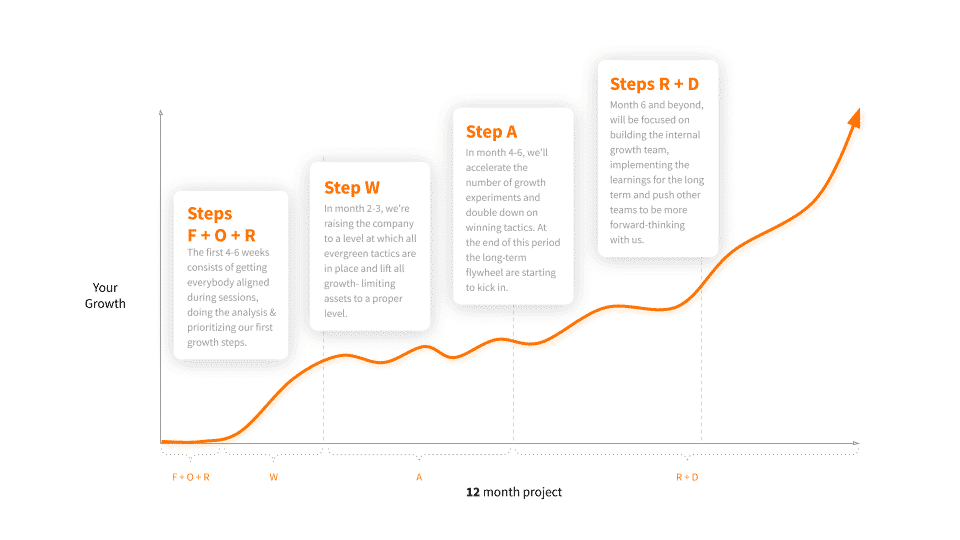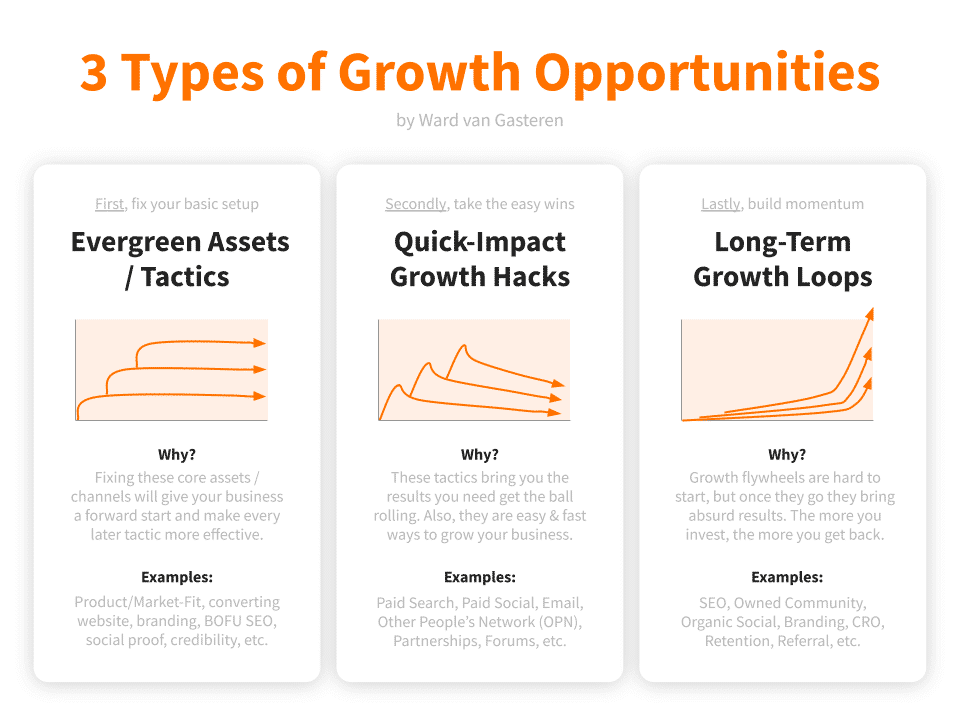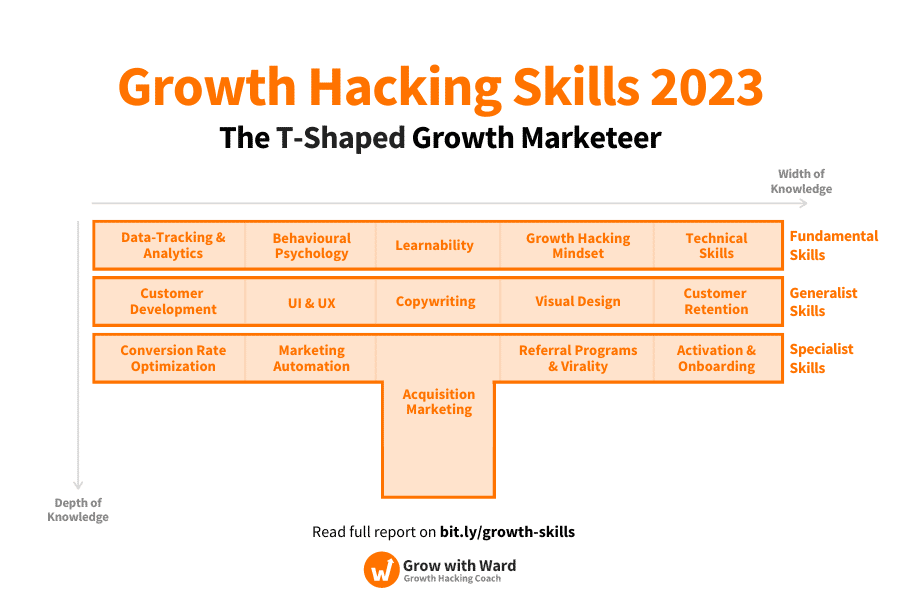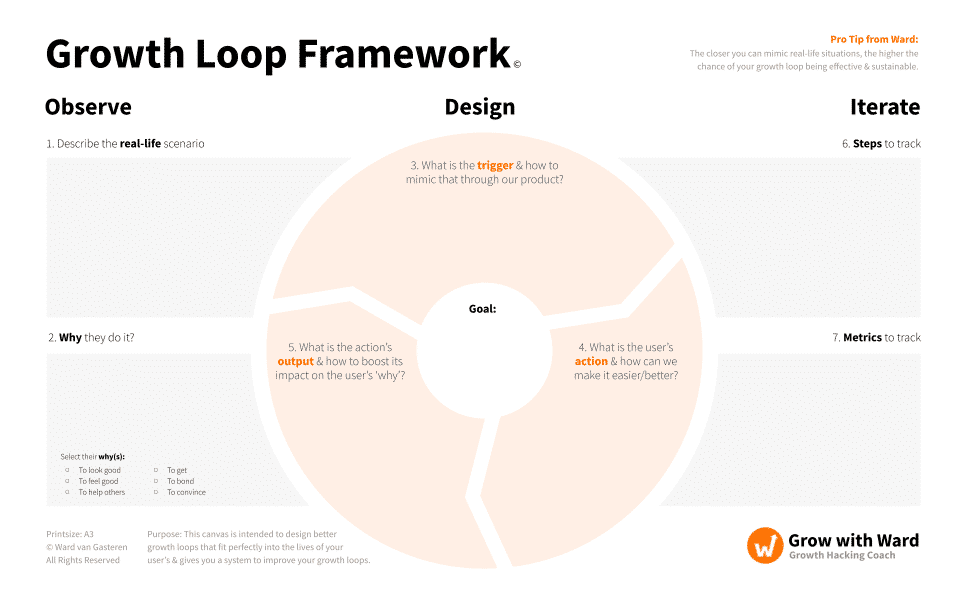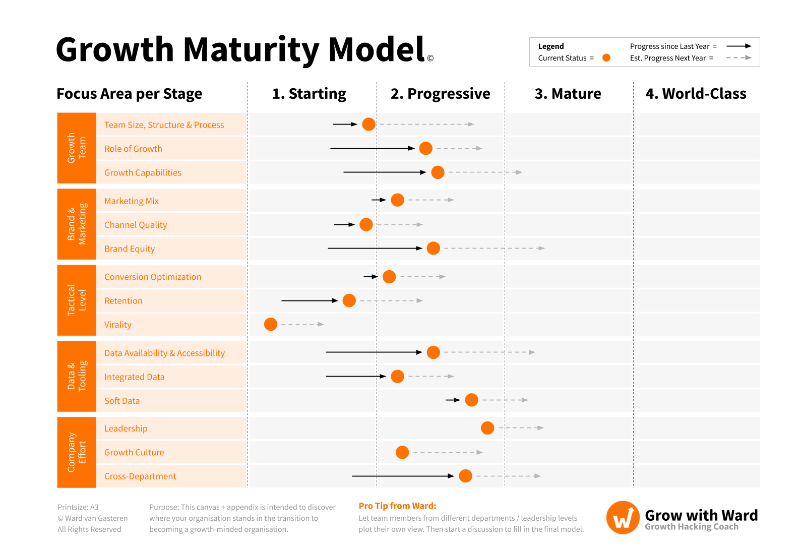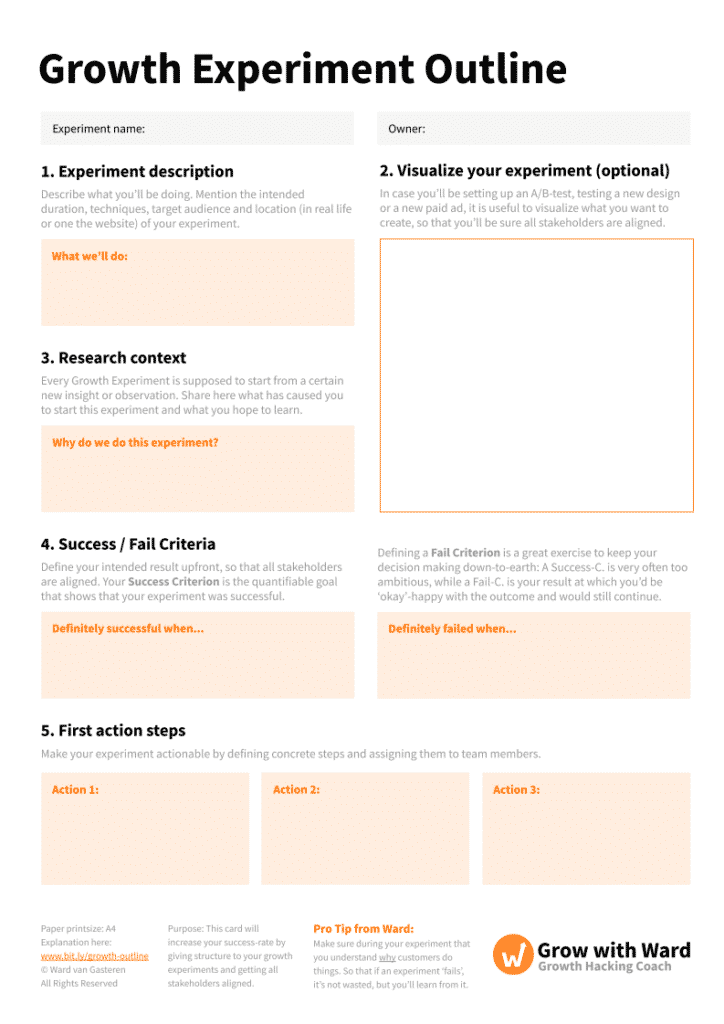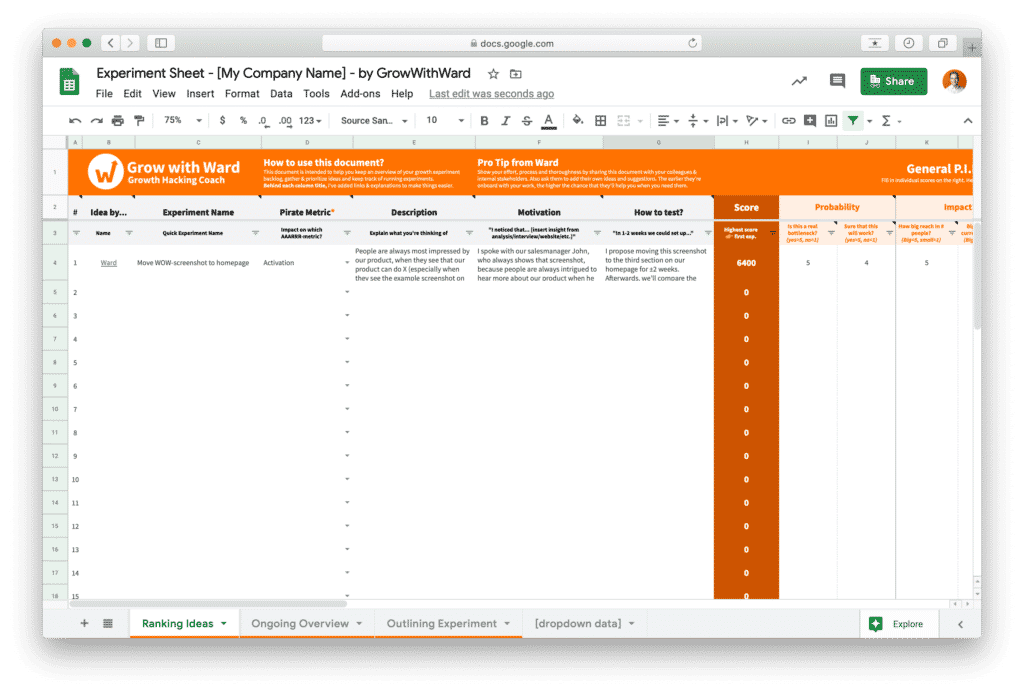Growth is not a one-trick pony. It's holistic.
Growth is not just a marketing or management job. It's a company-wide effort. After helping 70+ businesses grow, I’ve created my own process:
The 7 Phases of F.O.R.W.A.R.D™️ Growth.
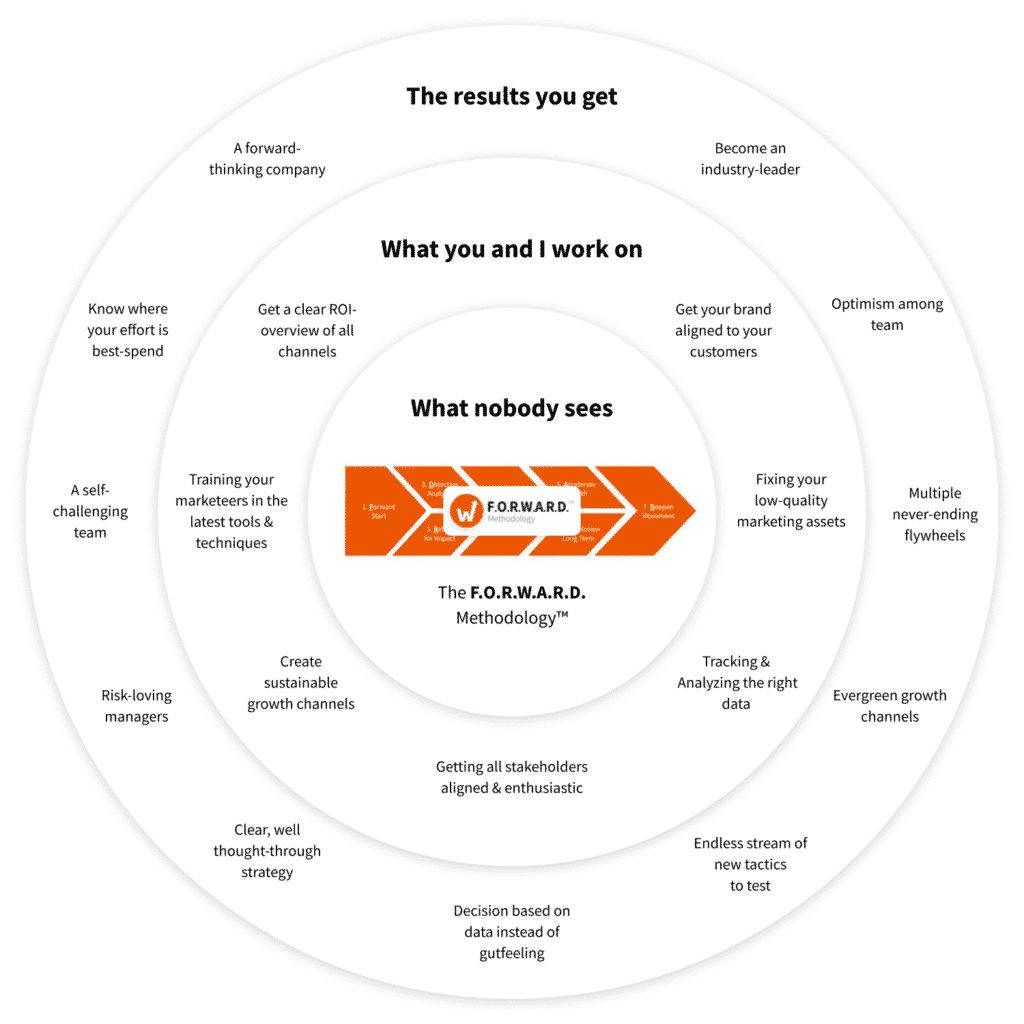
What others say
“Ward is very good at focusing his story to the listener. In our case, a more institutional context. In a short time he managed to convince the organization of the added value of growth hacking.”


Sylvano Aboikoni
Innovation Lead - MN Insurances
“I experienced the period that Ward helped us as very pleasant. Ward is a professional expert who provides clear advise and explains different topics in a way that everyone can understand.”


Rowan Stapelbroek
Marketing Manager - Prison Escape
Quick Navigation:
Ready to take control over your growth?
The F.O.R.W.A.R.D. Methodology™️: a proven process to get a company from stagnating growth to a forward-moving company again
The real best growth hack isn’t a particular type of marketing trick at all. It’s a well-defined, systematic process—a series of steps you need to take.

The F.O.R.W.A.R.D. Methodology™ is significantly different from what most growth hackers and agencies are doing. This is the first and only time I publish an overview of it. It doesn’t involve shoot-from-the-hip guesswork, and it doesn’t have the excitement and appeal of viral growth hacks. In fact, in many respects, it looks a lot like hard work. It requires experience, craft, and expertise in a wide range of disciplines. But experience has shown that it works, time and time again. It’s what I do every day for my coaching clients.
And I am proud that some of the most beautiful companies have adopted it; I’ve spent the past few years working with the biggest corporates and the most ambitious scale-ups.
And yes… I am aware that my name is inside the methodology, but hey: it’s my methodology, so I’m kinda allowed to put a pun in the name 😉
A step-by-step explanation of the F.O.R.W.A.R.D.-process
This page and this methodology will give you a more in-depth look at how I work, when consulting my clients, from startups to corporates. These are the 7 phases that each company should go through to transform from a stagnating business to a growing business with forward-minded people.
In total, this process takes about 6 to 18 months, depending on your company size.
In the end, everybody in your company will:
- Be focused on always giving more value to the customers, instead of internal focus on getting their tasks done and hitting their targets.
- Be able to adapt to changing times, so that when new problems arise, your teams are able to quickly adapt, thanks to the right skills and a growth mindset.
- Turn your company into an industry example of how business should be done, because you use rapid experimentation to work with the latest tools and techniques.
As said this process is not about just marketing and management. They are often the starting point, but it is about so much more: expectation management, setting priorities, team collaboration, product development, company culture and of course also marketing.
How this process is different for startups vs. scaleups vs. corporates:
The F.O.R.W.A.R.D. Methodology is my overarching way of working at any time, but of course it changes for smaller businesses, since you less stakeholder management and process usually goes a lot quicker, because you have a smaller organization to influence.
A step-by-step explanation of the F.O.R.W.A.R.D. Methodology™️
Step 1: Forward Start
Create momentum, urgency and cooperation for the long run
Getting a company to move is hard. So we first we need to focus on getting started under the optimal circumstances.
Just think of those times that you raised a new idea, that seemed such an obvious opportunity to go after. But, when you explained it to your boss, your boss didn’t really take the bait and it just seemed like he didn’t get it.
Or when a new initiative was started within your company: it got initiated, there was lots of excitement and in the end… nothing really changed and it ends up in the ‘we’ve already tried that’-box. If these examples speak to you: then this phase is what you needed.
In this first phase, you and I will need to take care of all the prerequisites for sustainable growth:
You’ll need a well-thought-through goal and strategy
Together with your team and all people who will be involved along the way, you and I will make sure that everybody is aligned on the process with the right mindset and make sure that everybody has the same expectations about our goals and the collaboratively defined North Star Metric.
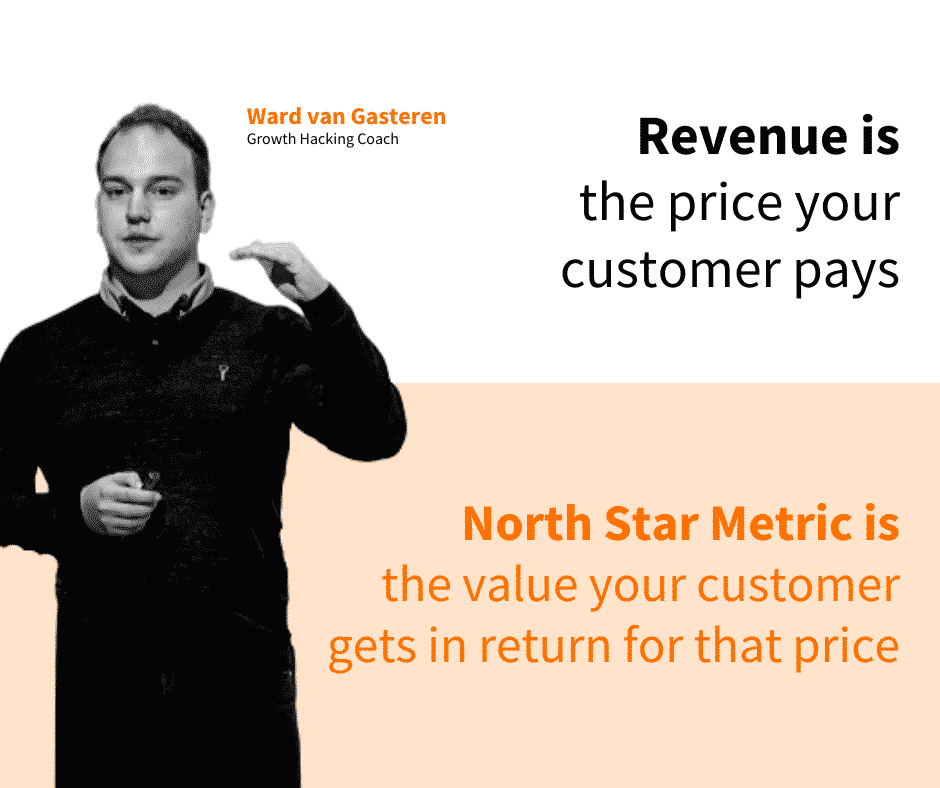
You’ll need the perfect launching team
It is important to have the right balance within your team: it should be between 3-5 people and be a mix of departments and personalities. This already-growth-minded team will need to bite through the hardest part of this journey: doing the dirty work. I’ll help you identify the right and the toxic people, and which departments you need to involve.
You’ll need the right momentum and urgency to get this flywheel moving.
Getting your company out of the current mindset and situation, moving forward into a more desirable situation is super hard. You’ll need to create urgency: not like Booking.com does, but the way your spouse does when they really want something – positive energy, proof of better times and a lovely excuse 😉
Lastly, your management needs to create a safe space for underperformance.
If the employees in your company are not taking enough risks, that’s not their fault, but that’s a leadership mistake. If you only give praise to people who deliver results, than nobody is willing to risk not delivering results. Your leadership team needs to start praising forward-motion, even if it doesn’t pay the bills at that moment. They need to look at the future potential of moving forward versus focusing on short term goals.
If done correctly, this phase will save you hours in emails, days of meetings or even years, if you’d need to do it all again. Thanks to this step your team will be excited, aligned and feels the urgency to start this new endeavour, everybody will be much more cooperative in every step along the way and everybody sees what the goal is at the end of this road.
Step 2: Objective Analysis
Understand where, what and why to focus
You have momentum, but your time is limited. How do you make sure that you hit all right spots?
With all the excitement from your team also comes a lot of opinions. People speak up about all those things that they feel you should pick up first. But if this movement goes in the wrong direction, we might end it up with mediocre results that disappoints people after a few weeks.
During this phase, we’ll uncover what parts of your business have the highest growth potential if we’d focus our momentum there.
First, you’ll need to know ‘where’ your growth is stagnating
Based on the Pirate Funnel Framework we’ll break up your company in different pieces to see what parts of your business are lacking. Do you have a marketing problem? Is your website your bottleneck? Or is your product the real problem? Knowing where we need to work will make every next step easier.
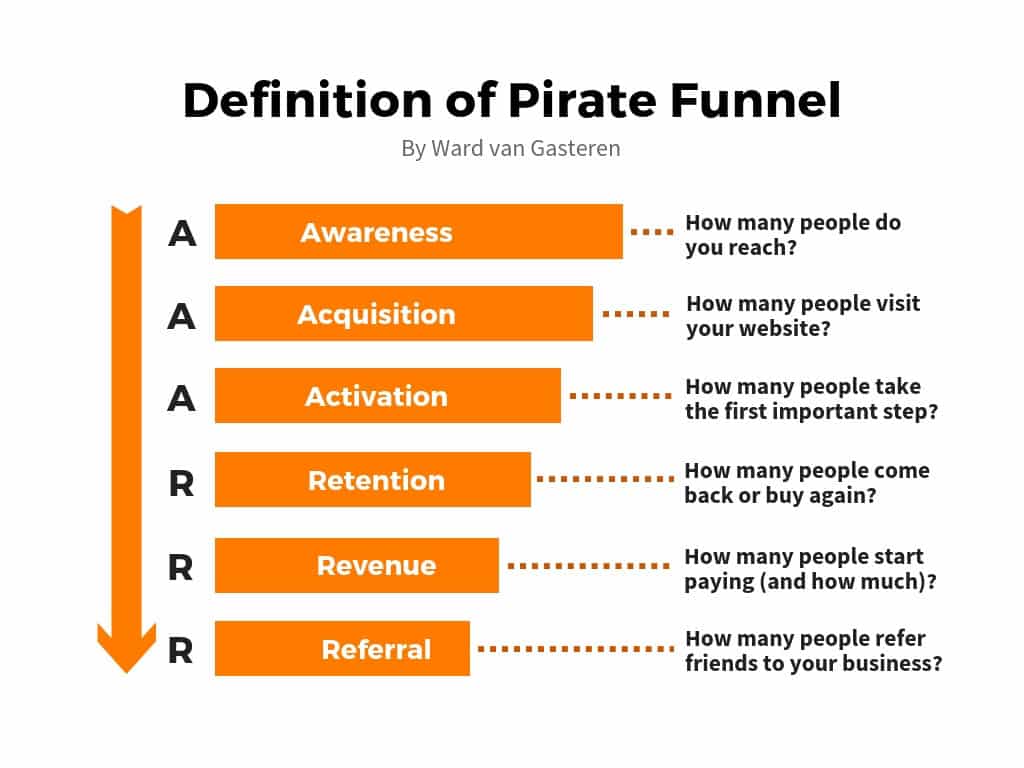
Second, you’ll need to find out ‘what’ is blocking that growth
Now that we know ‘where’ in your business things are holding you back, we need to dive deeper into data analysis to see (as specifically as possible) ‘what’ is holding you back. Thanks to the tools that fit the ‘where’, like Google Analytics, Google Tag Manager, SuperMetrics, Mixpanel or just your CRM, we’ll get the data we need.
Third, you’ll need to understand ‘why’ that is causing such a big blocker
We can try to fix the problem, but we should really try to tackle the cause. Working with Hotjar and your customer service teams will give us quick insights, but we’ll need to get into conversations with your customers to understand their exactly ‘how’ we should tackle this problem in the next phase.
This O-phase will help us to find focus in our journey and will make every step moving forward more effective on your revenue and growth. I will guide the team to define your Pirate Funnel properly, to certainly find the right metric and teach them the required skills to analyse data and interview users.
Step 3: Refine for Impact
Hit hard in the right places, instead of spreading thin
If you want to grow, you need to act.
But since this is only the start, you have limited time, budget and resources. It is important to hit the right targets to get more time, budget and resources. If you can’t get more of those things, neither you or I will be able to expand the growth efforts across the organization and keep it running in the long term.
Focus on high potential impact & low effort
Prioritizing our growth hacking experiments is very important: it will make sure that we focus our efforts on the low hanging fruits first. This shows that we are rightfully optimistic about the future – “See? It can really be that easy!”
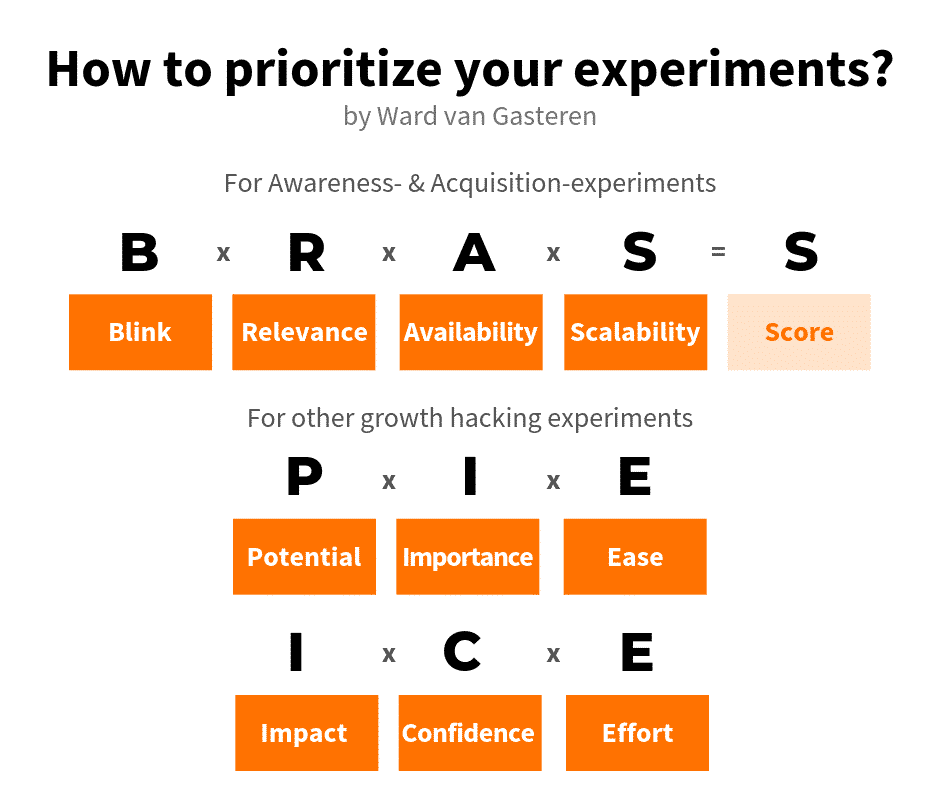
Your first target is to hit the target, that gets the least attention, but the most interest.
This will proof to the rest of the organization that we’ll make a difference and are a worthy investment. Also, it is very likely that this metric is a derivative of new ambitions within the company. If we would only focus on a high-impact and low-effort metric, we would probably end up to improve a unimportant metric, which won’t get us the momentum that we need for the long run.
You need to focus on one (and only one) metric: your OMTM.
At any given stage of our growth hacking journey, we always should focus our attention in one place. Spreading yourself thin across multiple metrics slows you down, gives mediocre input and increases overhead spendings. By focusing our attention on our One Metric That Matters (OMTM) for 2-4 months at a time, we make sure that you are always creating impact. I will help you determine the right metric and targets to hit.
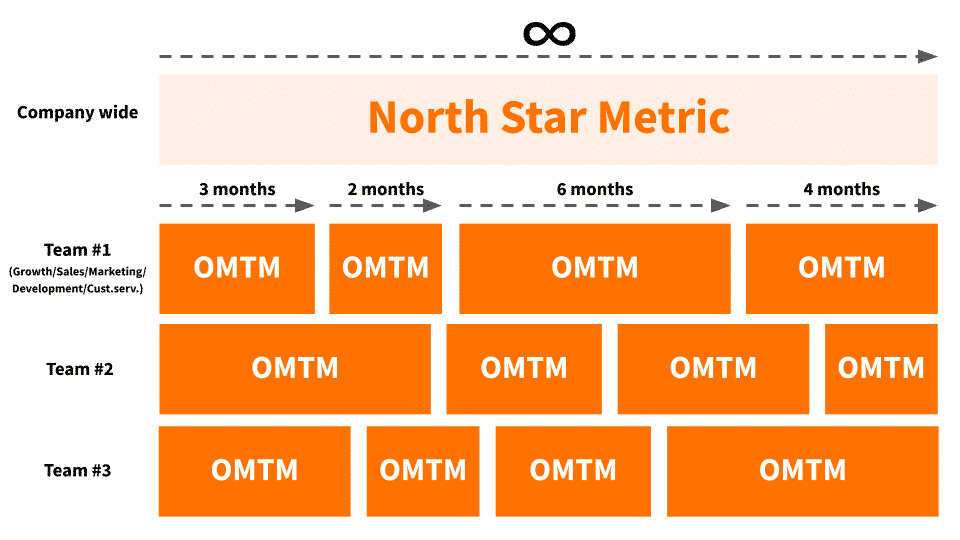
Making sure that you hit the right targets with big impact, will seriously shorten your roadmap to company-wide acceptance. It will also increase your team’s ROI, since you need to run a lot less experiments to get the same results.
Step 4: Win for Short Term
Showing the rest of the organization that this is a winning strategy
Nobody can guarantee quick results.
But on the other hand… quick results are necessary. How to maximize your quick win chances?
We need at least one big result. That’s why I work with rapid experimentation: the more we can test in the short term, the higher the chances that we’ll have at least one big win. On average, beginning growth teams have a success rate of 1:10, while I see for myself and more experienced growth hackers that we have a success rate of 1:3. Meaning that we can have 1 big win within 3 experiments.
For this you’ll need an independent T-Shaped team.
We need to deliver as much experiments as possible. Therefore, you need to be able to execute within the team, independently from other teams in your organization. If you need to wait every time that you need something designed, developed or even written, than you won’t be able to make enough progress. If needed, I can show the rest of the team how certain techniques need to be executed, or I can give training in any necessary skill around marketing, data or tech that you will need to execute your experiments.
In this stage, the 80/20-rule is our most important rule!
To get the maximum ROI on all our experiments, we need to keep our goal in mind: make progress on our OMTM, learn new growth levers and grow our North Star Metric. For this you have to prioritize ‘speed’ over ‘perfection’: if we can make more steps than your competitors, we will outrun them. This is the same reason why startups and scaleups like Amazon and Booking are growing so rapidly: they are busy to execute new ideas all the time, instead of doubting over perfection.
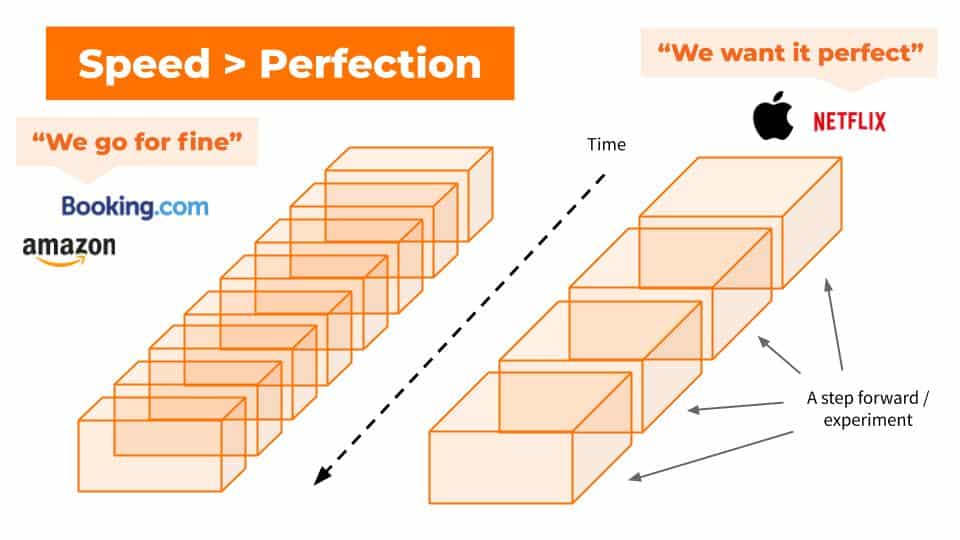
In this stage, it is indescribably important that you only focus on the minimum 20% of the work you need to do, that will give you 80% of the results. If you are focusing here on perfecting experiments, you’ll lose too much valuable time. During this process, I’ll be guiding you on what really needs to be done, based on previous experiments run, and which extra efforts are just nice-to-have.
In this ‘Quick Win’ phase of the F.O.R.W.A.R.D., we will give growth/growth hacking/growth marketing/forward thinking (or whatever we will call it) a definitive place in the organization and show everybody that this will bring the organization further.
Step 5: Accelerate Growth
When it gets busy, you need to get even busier!
The organization won’t be changed with just one experiment.
We’ll need to accelerate to get our flywheel moving. One of the characteristics is that a flywheel is hard to get up to speed, but once it’s moving, it starts to fly! This is the phase where we’ll double down on our first wins.
Collaborate with other departments to get experiments adopted
Comic book author Scott Adams once said: “Ideas are worthless. Execution is everything.” and he couldn’t be more right. We can launch the best ideas, but if they’re not perfected and implemented in the organization for the long term, the ideas are worthless. It is our job to involve other teams early on, so that they feel some ownership over our growth experiments, and we are able to get them implemented in the organization.
You need to balance your attention between ‘Initiating new ideas’ and ‘Rolling out winning experiments’.
Sadly every new win, will absorb a lot of our attention, since it now needs to be expanded, perfected and adopted for the long run. On average every winning experiment will take 4x the time that it took to set it up in the first place.
This will demand a lot of our attention, but we need to make sure that our growth team doesn’t become an optimization team, because then we will slowly lose our impact. In this stage it is important to keep momentum and I’ll be there to take away your growth obstacles and challenge you to actually keep accelerating your growth.
You won’t like it, because you will feel as if you’re demanding to much from your team, but it will force you to become more efficient and not get sucked into perfection.
Possibly we need to expand our team with less T-shaped players
As said you might need to delegate tasks and at this stage you might need to hire some freelance specialists, who can help to perfectionate a winning experiment in their expertise.
It will give you more space to focus on new ideas and, since they’re experts, they’ll probably deliver twice the quality in half the time. And they might have extra ideas that we as generalist T-shaped players wouldn’t even think off. I’ll gladly share my network with you to find proper freelancers with a forward-mindset who can help you accelerate even faster.
So make sure that your previous successes won’t slow you down, but that they become a stepping stone towards even faster growth. You can’t do everything on your own, so knowing how balance your attention and resources is key here!
⚠️ Until this step, you might have already figured it out yourself. The R+D steps of the FORWARD model are completely optional and only intended if you also want to change the human aspect of your business in the long term. I suggest that we always focus on steps F through A for rapid growth (± 6 months) first, and we’ll see the other two steps later, so don’t get overwhelmed!
Step 6: Revolutionize for Long Term
Kickstart the flywheels of other teams to have impact for years
Your team is on fire and everybody is stunned by your results. Now is the time to start a revolution!
This growth movement isn’t a one-team-job: you’ll need to spark the other departments to work with you and get inspired to copy your forward-minded way of working. Step-by-step those earlier internally focused people, will become forward-focused people.
If you’ve done your internal communication correctly, all those other teams see what you’ve caused and will be eager to start. It’s our job to get some extra initiators started in the other teams and coach them on how they can get their flywheel moving as well.
You’ll need to identify and inspire your Coaches, Initiators and Decision Makers early on.
You cannot manage the whole organization at the same time: you’ll need Coaches in the others teams (those who’ll take your role in the other departments). But to get them started you need to identify who will be the Initiators within each department, empower them to start the movement and convince the Coaches to hop on that wagon as well. And of course, you should’ve already been priming your Decision Makers from the start, so that they see the added benefit to their strategic plans. No need to worry: I’ll help you identify and nurture them every step of the way.
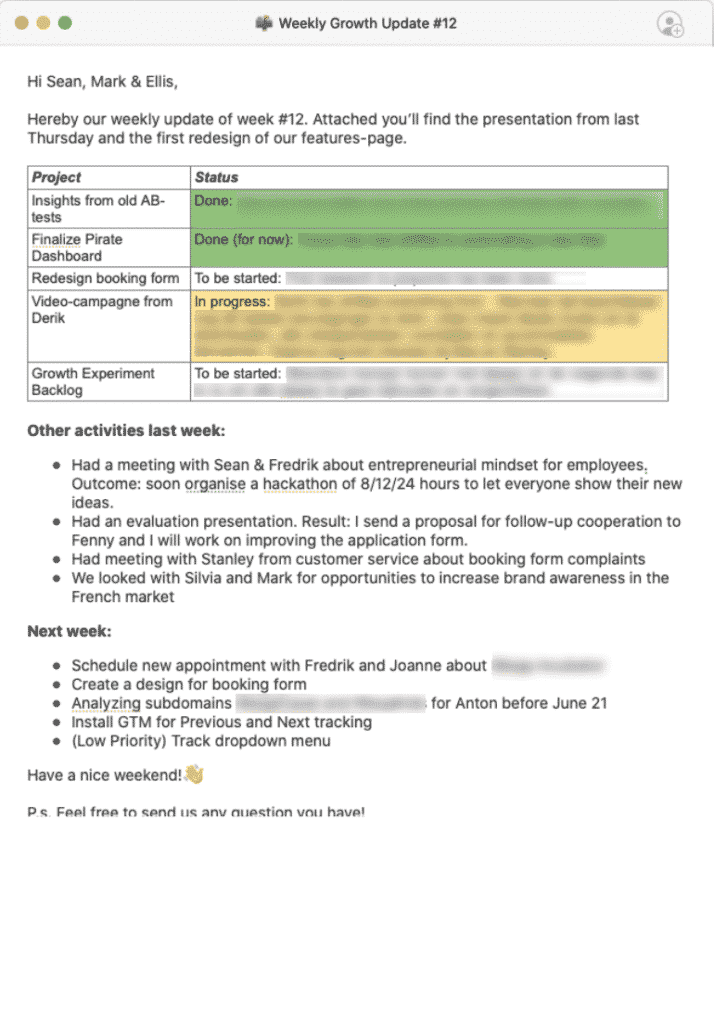
If done correctly, this is the step that will change your company for the long run. This is the point where your company culture starts to change to an optimistic, forward-thinking organization. Later on your company brand, your product quality and industry status will change for the better as well, but it takes time!
Step 7: Deepen Movement
Sustainable growth has to come from top, middle and bottom of organization
I won’t be with you forever. Once my work is done, I’ll move on to the next amazing company to work with. And the same goes for you one day.
So how do we make sure that this forward-minded way of working doesn’t depend on one of us? I’ll help you to deepen this mindset in your organization.
You’ll need forward-focused leaders at the top to secure your forward movement.
If not you, than somebody else needs to become your Head of Growth or VP of Growth, but also your other leadership positions need to be filled with forward-focused people with an infinite mindset. Know that these are not regular leaders, but these are people who will empower their teams to make the most of it (instead of only managing their risks).
You need optimistic new talent & skills at the bottom.
Your company recruitment needs to attract optimistic and talented people, by changing your employer branding. These new people will give you an infinite sources of bottom-up forward thinking. They will challenge you to keep moving forward and make sure that “That’s how we’ve always done it” never becomes a valid excuse. Also you’ll attract talent from other ambitious, growing companies, which will bring you more insights and brings you new techniques that work for others.
You have to know how to handle toxicity.
There will always be people who are more focused on minimizing their risks, by limiting the amount of new experiments, by lowering the bar so they never underdeliver and even by stabbing other people in the back when they move forward. You don’t need to fire them: this is not their fault, but it’s a management mistake! Your management needs to focus on long term, even if that means losing a bit in the short term. In the meantime, these toxic people need to managed by giving extra support, training, feedback and opportunity. Letting people go is always your very last option.
If you can deepen the forward-mindset in your organization, your company will grow for years to come and believe me: it doesn’t matter how big your results are in these first 6-18 months, because the results that will come in the next years will be exponentially bigger each year.
Conclusion
As this overview has shown, the F.O.R.W.A.R.D Methodology™ is not about growth hacking; it’s a process of activities that encompass a wide range of disciplines and growth hacking is only a vehicle to get your company to grow.
Although this process sounds less appealing than applying “growth hacks”, I don’t know of an easier, more reliable way to grow an online business.
“Ward brings a unique value to companies: with his broad knowledge of the many possibilities, the exact benchmarks, the many different branches and his previous hands-on experience, he can grow any company.”


Bernadette Bijkerk
Growth Specialist - Talpa Network
“Ward is a sincere and interested person who has a lot of knowledge and experience of the online shopping street. Ward simply translates complex matter into understandable language.”


Rik Stapelbroek
CEO & Founder - Real Life Gaming
Let's do a 1-on-1 discovery call
What we’ll discuss in this call:
- See if there's a good fit between us
- Your current situation & desired outcome
- Discuss together how I can best help you
“With his patience and knowledge, Ward has brought us an enormous amount of knowledge on the subject of Growth Hacking, including all data & technical skills. We were able to apply this knowledge directly in practice.”


Merel Kerkhof
Online Marketeer - Studio WHY
“Ward challenged and guided us in our innovation-projects. I have mastered many of his skills through his clear explanation with sharp analyzes. Here I am still reaping the benefits!”


Thomas van der Vliet
Innovation Manager - Riksja Travel
